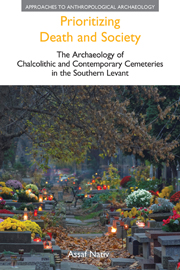 Prioritizing Death and Society
Prioritizing Death and Society from Part II - Chalcolithic cemeteries
Unlike other cemeteries of the Chalcolithic period discussed above, the cemeteries that are the subject of this chapter are located above ground. While varying in size, complexity and detail, their position above ground provided them an explicitness of presence that the other burial sites did not have. As a rule, subterranean cavities are indistinguishably embedded within the landscape and practically unnoticeable to those walking above ground. Freestanding structural features, however, can hardly go unnoticed. This appears to suggest a degree of assertiveness that may have facilitated modes of articulation and signalling that were less explicit when caves were in use.
This difference suggests profound implications that may be read in various ways. It may have signalled ownership of land and resources, it may have provided a powerful vehicle to articulate the relationships between the living and their ancestors, or it may have symbolized that the dead were not integrated into the landscape but remained distinct. Whatever one's interpretation, these cemeteries evidently constituted a class of a different order. Our task is to determine whether these differences also crossed over to the cemeteries' structure and dynamics.
Unfortunately, however, the data available for discussion are somewhat limited. To date, only three cemeteries of this kind have been excavated — Palmahim (North), Shiqmim and Nahal Sekher; and of these, only the first two have been published in any detail. Moreover, although excavations followed high standards of conduct, considerable differences in preservation render many strands of data differentially available.
To save this book to your Kindle, first ensure [email protected] is added to your Approved Personal Document E-mail List under your Personal Document Settings on the Manage Your Content and Devices page of your Amazon account. Then enter the ‘name’ part of your Kindle email address below. Find out more about saving to your Kindle.
Note you can select to save to either the @free.kindle.com or @kindle.com variations. ‘@free.kindle.com’ emails are free but can only be saved to your device when it is connected to wi-fi. ‘@kindle.com’ emails can be delivered even when you are not connected to wi-fi, but note that service fees apply.
Find out more about the Kindle Personal Document Service.
To save content items to your account, please confirm that you agree to abide by our usage policies. If this is the first time you use this feature, you will be asked to authorise Cambridge Core to connect with your account. Find out more about saving content to Dropbox.
To save content items to your account, please confirm that you agree to abide by our usage policies. If this is the first time you use this feature, you will be asked to authorise Cambridge Core to connect with your account. Find out more about saving content to Google Drive.